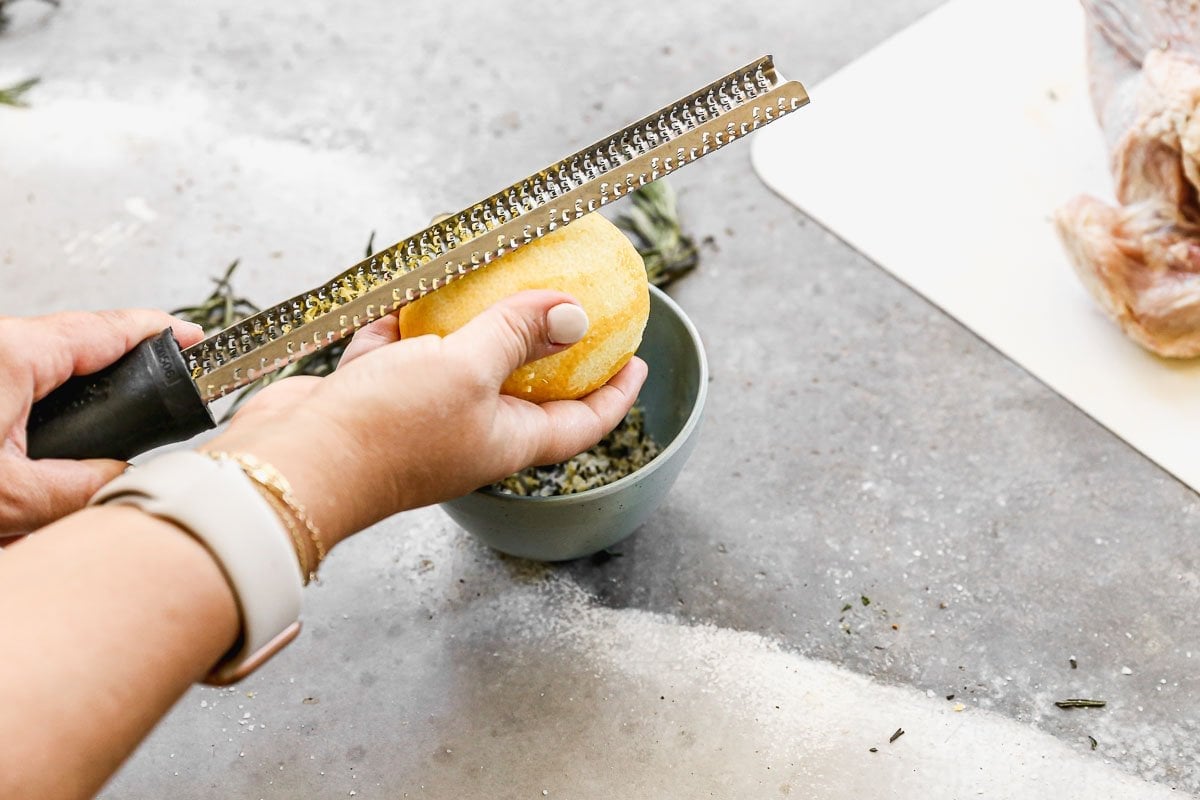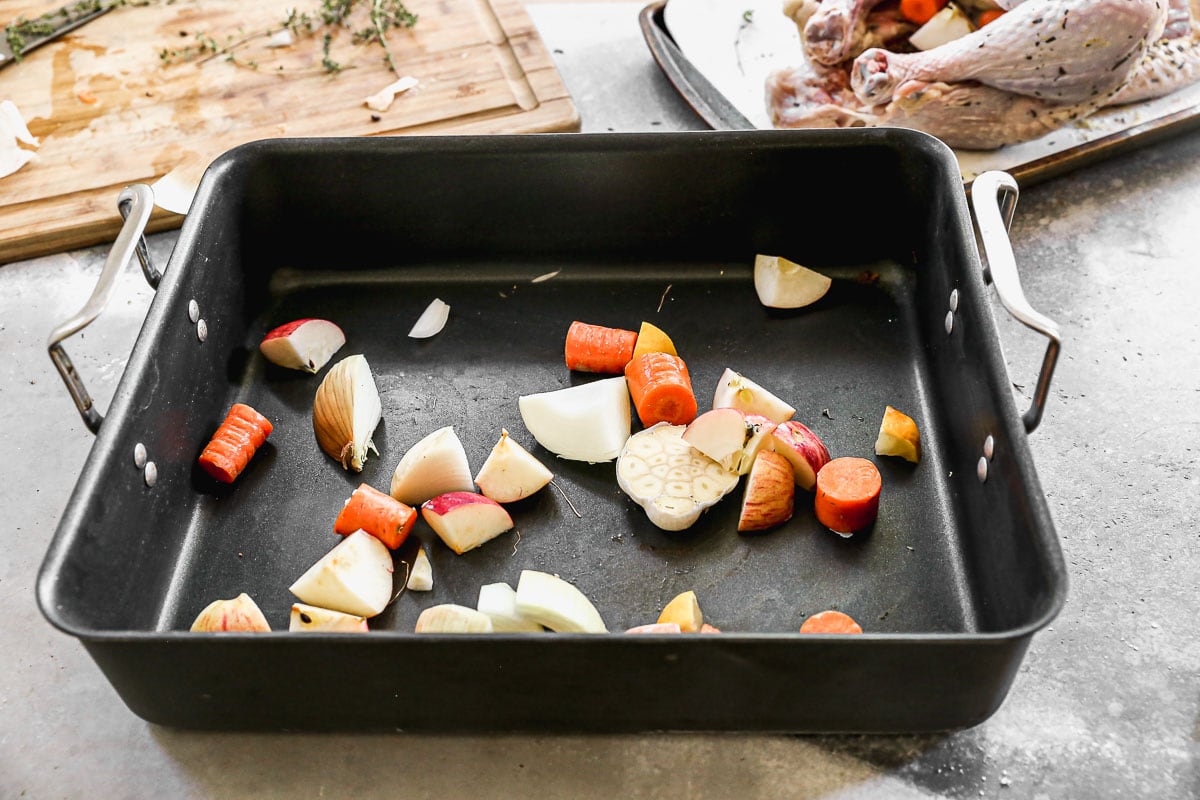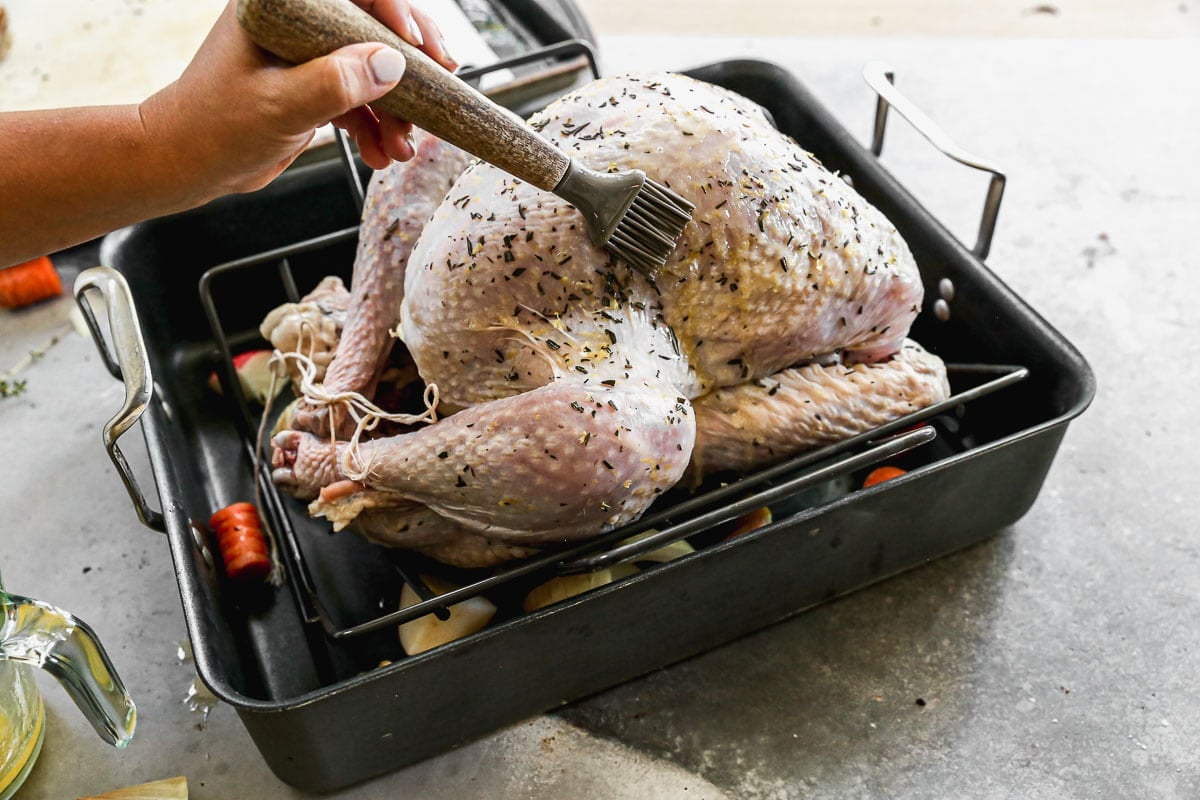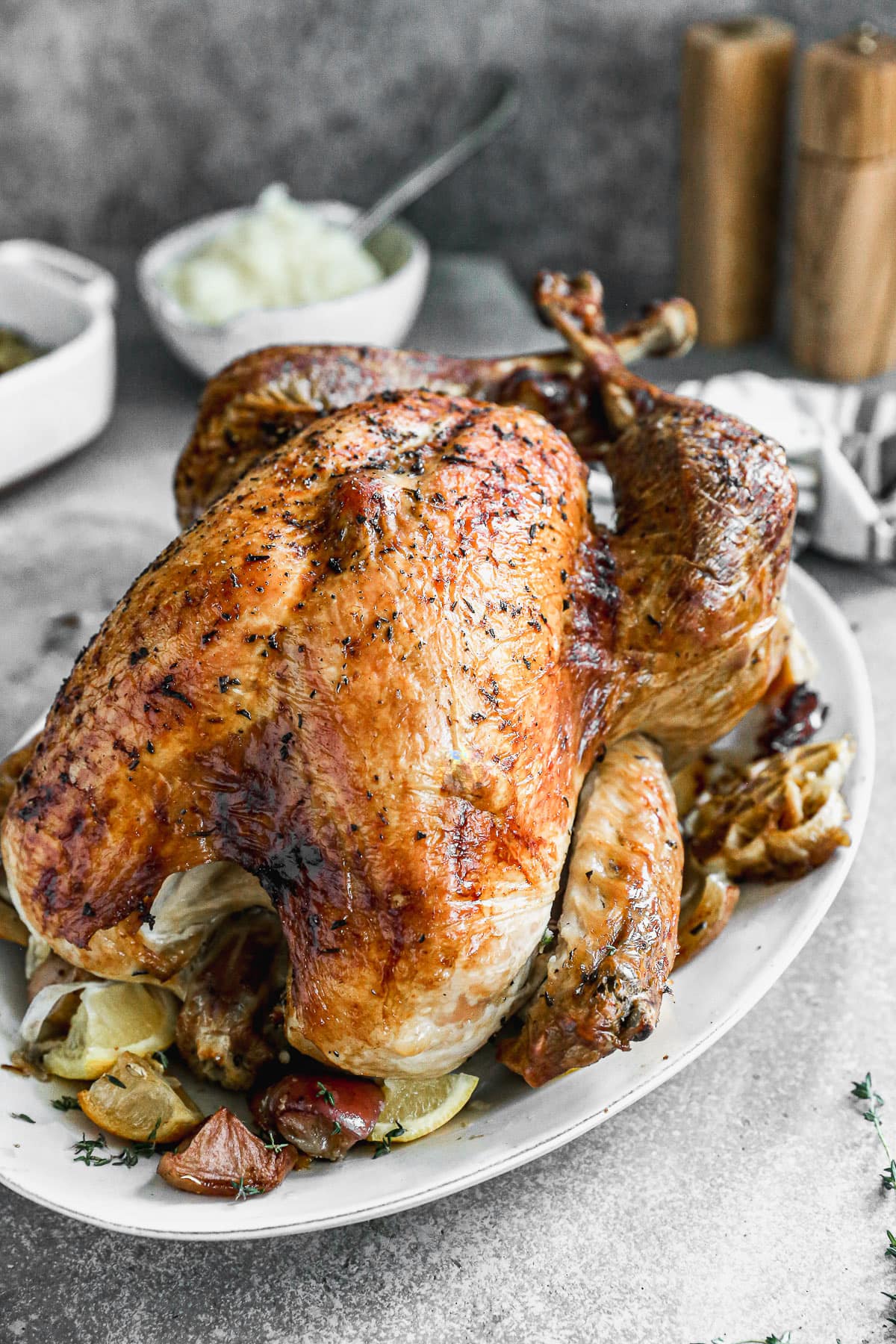I’ve come a long way since cooking my first turkey for Friendsgiving at the age of 22. From wet brines to dry brines, to roasting at different temperatures, to basting/not basting, turkey bag/no turkey bag, covered/uncovered, I HAVE TRIED IT. This post tells you exactly what you need to know! Follow this post and you’ll cook a perfect turkey that is moist, not dry every single time. Let’s talk turkey!
Roast Turkey Timeline
Start at least 24 hours ahead for a thawed turkey and up to 5 days ahead for a frozen turkey.
4 to 5 days before roasting. Thaw the turkey.1 to 3 days before roasting. Brine the turkey using a wet turkey brine (1 day before) or a dry brine (2 to 3 days before).1 day before or the morning of roasting. Refrigerate the turkey uncovered to dry the skin.1 hour before roasting: Preheat the oven; let your turkey come to room temperature; stuff and tie the turkey, then place it on your roasting pan.Roast the turkey (2 to 3 hours). The timing will vary depending on its size. See How Long to Cook a Turkey for details. Plan on between 2 and 2 ½ hours total for a 14- to 16-pound bird. Start at a high temperature (450 degrees F for 45 minutes), then reduce to 325 degrees F.Let the turkey rest (30 minutes). Cover the turkey with aluminum foil to help it retain heat.Make the gravy. Or heat up pre-made gravy. This Turkey Gravy recipe uses the drippings; this Mushroom Gravy can be made entirely in advance, no drippings required.Carve the turkey. See our turkey carving tutorial for step-by-step photos.
Now, let’s look at each step in detail.
Buy Your Turkey
Whenever possible, I prefer to purchase a fresh turkey from a local butcher for two great reasons. As far as the size of turkey to buy, you can plan on 1 1/2 pounds per person, or 2 pounds per person if you have big eaters and/or want leftovers. See How Much Turkey Per Person for more.
Thaw Your Turkey
If you purchase a frozen turkey, you must thaw it first. You cannot roast frozen turkey.
The outside meat, especially the breast meat, will be very dry by the time the inside is cooked to a safe temperature.
Brine Your Turkey
The best way to keep your turkey from drying out is a) not to overcook it and b) BRINE IT.
Brining alters the structure of the meat, such that it can absorb and retain more moisture.It also flavors the turkey, especially the skin.
I honestly think that most people find turkey dry or cannot cook turkey because they don’t bother to brine it. I’ve cooked a turkey without brining, and while it was edible, you simply cannot create turkey that is moist throughout (including moist white meat) unless you brine it first. You can choose either a wet brine (turkey is soaked in a seasoned saltwater solution for 12 to 24 hours) or a dry brine (a mixture of salt and seasonings, such as herbs and lemon zest, is rubbed on the turkey and allowed to sit for 24 to 48 hours).
I prefer a dry brine because it is much less messy than a wet brine and still has great results.If you are in a hurry, wet brine works more quickly and arguably produces a slightly juicier, more plump turkey than a dry brine.
Dry Out the Skin
While not 100% necessary, uncovering the turkey and allowing it to sit uncovered in the refrigerator the day before or even several hours before roasting helps the skin dry out, resulting in crispier skin.
If you are using a wet brine, you will need to rinse off the brine first or the turkey will be too salty.If using a dry brine, you do not need to rinse it off.
Stuff the Cavity
To flavor and perfume your bird, fill the cavity with a variety of herbs and aromatics.
Onion and/or Garlic. Split the garlic in half and cut the onion into wedges. No need to peel either, as they will be discarded.Apple Slices. They give the turkey fall fruitiness (no need to peel or core).Carrots. For an extra dimension of natural sweetness.Herbs. Add several springs of fresh thyme, sage, and/or rosemary.
Tuck the Wings
Start by pulling out the wings, then bending and tucking them underneath the neck end of the turkey will prevent them from burning. See photos above.
Tie the Legs
To help the turkey roast evenly, use kitchen twine (or if you don’t have any, a rope of aluminum foil) to snugly tie its legs together.
Fill the Roasting Pan
To flavor your turkey even more, scatter any extra aromatics that don’t fit in the cavity in the bottom of a large roasting pan. They’ll mix with the drippings to create fabulous pan juices.
The best roasting pan for turkey is at least 16 inches long and 4 inches deep, with big sturdy handles so it’s easy to lift (this is a good option).If you will be roasting a turkey that is 20 pounds or more, purchase a roasting pan that is at least 18 inches.If you don’t own a big roasting pan, purchase a disposable aluminum roasting pan from the grocery store.
Place a Rack in the Pan, then the Turkey on the Rack
Using a rack elevates the turkey off of the surface of the pan so the air can more evenly circulate.
Butter It Up
Brush the outsides of the turkey liberally with melted butter and season with pepper.
Tear off two similarly-sized, large pieces of aluminum foil.Tightly roll each piece into a cylinder, then form the cylinders into rings. Lay the rings a few of inches apart in the roasting pan.Place the turkey on top of the rings so that it’s elevated and its weight is evenly distributed.
Butter helps the skin become beautifully golden and adds fantastic flavor.
Add Liquid to the Pan
Pouring liquid into the roasting pan helps keep the turkey moist and gives you more juices to use for gravy or for serving at the end.
Cook the Turkey
The best way to cook turkey in the oven is to start it at a high temperature to crisp the skin, then reduce the temperature until the turkey is succulently juicy.
To add wine, set the roasting pan with the turkey on the oven rack, THEN pour in an entire bottle of dry white wine, such as Sauvignon Blanc or Pinot Grigio (if you pour the wine in the pan before setting it on the oven rack, it’s harder to transfer without sloshing).If you prefer not to use wine, add 4 cups of chicken or turkey stock to the pan instead.
First: Cook the Turkey at 450 Degrees F for 45 Minutes
Starting the turkey at a high temperature results in better, crispier skin.
Then: Reduce the Oven Temperature to 325 Degrees F and Keep Roasting
325 degrees F is the best temperature for roasting turkey.
Any higher for a prolonged period and the delicate white meat will cook too quickly.Any lower, and some of the juices can slowly dry out (and it will take much longer).
325 degrees F is the sweet spot for cooking turkey!
Check Your Turkey for Doneness
Per the FDA, turkey is considered cooked at 165 degrees F. The turkey’s temperature will continue rising as it rests.
I recommend cooking turkey until the internal temperature of the breast registers between 150 and 160 degrees F on an instant read thermometer.At this point, the thigh temperature may be higher, which is OK since turkey thigh meat is more forgiving. Ideally, the thigh won’t be hotter than 170 degrees F, but don’t stress if it is.
Turkey Cooking Times (DON’T OVERCOOK THE TURKEY!)
The rule of thumb for cooking a 14- to 16-pound turkey at 325 degrees F is 10 to 12 minutes per pound of turkey.
I do not recommend the pop-out thermometers that come with some turkeys, as they tend to be inaccurate.A digital read thermometer like this one is inexpensive and well worth not ruining your turkey!
A 14- to 16-pound turkey takes 2 to 2 ½ hours to roast. Add or subtract time if your turkey is larger or smaller. Check early! You can always keep roasting, but if you overcook a turkey, it will be dry.Anticipate a range. Turkey cooking times vary by oven and by bird no matter how many times you’ve done it. Expect a range (AND CHECK EARLY!)Note that if you are opening and closing the oven often towards the end, this can extend the cooking time for 30 minutes or more. Be flexible and don’t stress!
For a complete overview, see How Long to Cook a Turkey.
Let the Turkey Rest
Resting turkey meat for a minimum of 20 minutes is MANDATORY.
When you rest turkey, the juices reincorporate into the meat.If you cut right away, all of those beautiful juices will run away onto your cutting board.
I prefer to cover my whole turkey with foil while it rests (the skin still stays crispy, even covered), but if your turkey is overcooked, you may want to leave it uncovered. It will still stay plenty hot.
Make the Gravy
While the turkey rests is the perfect time to make gravy.
If you’ll making Turkey Gravy with drippings, separate the fat first (I use a fat separator).You can also make gravy 100% in advance and just reheat it on the stove. See make-ahead Mushroom Gravy also coming soon!).
Carve the Turkey
For a complete step-by-step, see How to Carve a Turkey.
If possible, use a great big cutting board with grooves like this.Even after the turkey rests, it will still be super juicy, so the grooves help.Eventually, I invested in an electric knife because it makes carving speedier, but a sharp knife (like a chef’s knife) will do the job.
DIVE IN!
Bask in the glory. You cooked a MOIST Thanksgiving turkey that your friends and family will rave about for years to come!
Turkey Cooking Tips & Tricks
Any Brining is Better Than No Brining. Even a few hours is better than skipping brining altogether.If You are Short on Time, Use a Wet Brine. Wet brining works faster than dry brining, so if you are short on time (have 12 hours or less), do a wet brine.If You Forgot to Brine. Salt and pepper the outside of the turkey GENEROUSLY (including inside the cavity). Mash a stick of softened butter together with chopped fresh herbs, lemon zest, and salt and rub it under the turkey skin. Brush the turkey with melted butter prior to roasting.Cook the Stuffing Outside of the Bird. I know some like cooking stuffing inside the cavity, but it can be a hazard because the stuffing also has to reach 160 degrees F, and if it’s not there yet, you’ll overcook the turkey (plus there is never enough to go around!). Make a pan of Cornbread Stuffing instead (technically if the stuffing is cooked outside of the bird it is called dressing, but by any name, it’s delish!).Don’t Bother Basting. Pouring wine or stock in the roasting pan prior to cooking will keep it plenty moist (in a total pinch, you can pour water in the roasting pan).Shield the Turkey Breast. About 1 hour into roasting, shield the breast only with aluminum foil. This will help protect the white meat and keep it moist.Don’t Cover the Turkey Completely. You want that skin to crisp, so it needs to be exposed to heat.DO NOT OVERCOOK THE TURKEY. The magic number is 155 degrees F for the breast (and up to 165) and 160 degrees F for the thigh.Use an Instant Read Digital Thermometer. Do not use the pop-up kind (these are inaccurate). This one is inexpensive and does the job; this one is my absolute favorite and well worth the investment.Skip the Gravy. If it stresses you out, don’t make it! Follow this recipe and your turkey will be so moist, you won’t need it. You can spoon the juices from the roasting pan onto your meat instead.
Turkey Tools
Roasting Pan. It’s essential that you have something large enough and (ideally) sturdy enough to support your turkey. Electric Knife. Makes carving the turkey so much easier. Cutting/Carving Board. This cutting board holds your turkey in place and keeps the juices from running all over your counter. Apron. Keep your clothes stain-free for Thanksgiving dinner with a cute and washable apron.
Thanksgiving Sides
Complete your Thanksgiving spread with a collection of fabulous side dishes.
Mashed Potatoes. Crockpot Mashed Potatoes and Instant Pot Mashed Potatoes are sure to be a hit. Sweet Potatoes. Healthy Sweet Potato Casserole and Glazed Sweet Potatoes are irresistible.Cranberry Sauce. A classic part of a Thanksgiving spread! Try my Cranberry Orange Sauce or Cranberry Orange Relish.Brussels Sprouts. Free up oven space with these Crockpot Brussels Sprouts, or serve these fan-favorite Maple Bacon Brussels Sprouts. Salad. Everyone will make room on their plates for Winter Salad or Apple Walnut Salad.Stuffing (er, Dressing). Keep the oven free for your turkey by making this Crockpot Stuffing. We also love this Chestnut Stuffing.Dessert! From Sweet Potato Pie to Pecan Pie Bars, you can’t go wrong.
For even more options, check out our complete collection of Thanksgiving Side Dishes.
Storage Tips
To Store. Refrigerate turkey in an airtight storage container or ziptop bag for up to 4 days. To keep the meat moist, drizzle a little of the turkey pan drippings or broth over the top before refrigerating it.To Reheat. Wrap the turkey in an aluminum foil pouch, sealing it at the edges. Drizzle turkey drippings or broth over the meat before sealing. Warm the pouch in a baking dish in a 300 degrees F oven.To Freeze. Freeze turkey in an airtight freezer-safe storage container for up to 3 months. Let thaw overnight in the refrigerator before reheating.
Now you have it: Everything you need to know to cook moist turkey in the oven that will have your guests gushing, without the stress. Leave a rating below in the comments and let me know how you liked the recipe. HAPPY HOLIDAYS! If you try this roast turkey recipe, I’d love to hear how it goes!
Crockpot Green Bean Casserole
5 hrs 50 mins
Cranberry Orange Sauce
20 mins
Vegan Thanksgiving Recipes




































